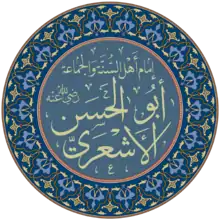Ibn Hibban
Muhammad ibn Hibban ibn Ahmad al-Tamimi al-Busti (Arabic: محمد ابن حبان البستی) (c. 270–354/884–965) was a Muslim Arab[3] scholar, Muhaddith, historian, author of well-known works, “Sheikh of Khorasan”.
Ibn Hibban ابن حبان | |
|---|---|
| Personal | |
| Born | 270 A.H. (884 CE) Bust (current name Lashkargah), Afghanistan |
| Died | 354 A.H. (965 CE) Bust (current name Lashkargah), Afghanistan |
| Resting place | Lashkargah), Afghanistan |
| Religion | Islam |
| Ethnicity | Khurasani |
| Era | Islamic Golden Age, Middle Abbasid era |
| Denomination | Sunni |
| Jurisprudence | Shafi'i[1] |
| Creed | Ash'ari[2] |
| Main interest(s) | Hadith studies |
| Notable work(s) | Sahih Ibn Hibban |
| Occupation | Muhaddith, Hadith compiler, Islamic scholar |
| Muslim leader | |
Influenced by
| |
Influenced
| |
| Arabic name | |
| Personal (Ism) | Muhammad (محمد) |
| Patronymic (Nasab) | Ibn Hibban ibn Ahmad ibn Hibban (ابن حبان ابن أحمد ابن حبان) |
| Teknonymic (Kunya) | Abu Hatim, Abu Bakr (ابو حاتم, ابو بكر) |
| Toponymic (Nisba) | al-Tamimi al-Darimi al-Busti (التمیمی الدارمی البستی) |
Biography
Ibn Hibban was born in 270 AH (884 CE) in Bust or Bost in present-day southern Afghanistan[4] (former name of Helmand province capital was bost or bust, its new name is Lashkargah).[5] He studied Islamic sciences with many prominent scientists of the time, as al-Nasa'i, al-Hasan ibn Sufyan, Abu al-Ya'la al-Mosuli, al-Husayn ibn Idris al-Harawi, Abu al-Khalifa al-Jamhi, Imran ibn Musa ibn Madzhashi', Ahmad ibn al-Hasan al-Sufi, Ja'far ibn Ahmad al-Dimashqi, Abu Bakr ibn Khuzaymah etc. His students included Muhammad ibn Manda, Abū 'Abd-'Allāh al-Hakim and others. Ibn Hibban Acting Qadi in Samarqand, well versed in fiqh, hadith and the sciences of astronomy, medicine and many other disciplines.
According to his own words, whenever he was in Mashhad during distress, he would visit Imam Reza Shrine and ask for relief that would always come, “time after time again”.[6]
Ibn Faisal died in Bust on a Friday night, eight days before the end of the month of Shawwal in 354 AH. He was buried in his native town Bost or Bust (currently Lashkargah) in present-day southern Afghanistan.
Theology
When returning to Sijistan, after studying in Nishapur with Ibn Khuzaymah, Ibn Hibban was opposed by some of the Hanbalis as he taught that God does not have limits, rejecting their [[Anthropomorphism#In religion and mythology belief in al-Hadd lillah (limits for God).[1] Furthermore, these local Hanbalis accused him of Zandaqa (heresy) for his statement al-Nubuwwa 'ilmun wa 'amal (prophecy consists of a knowledge and action).[1] Due to this he left for Samarkand, where he became a Judge.[1]
One of his enemies, al-Sulaymani (d. 404/1014) claimed that Ibn Hibban owed his appointement to Samanid vizier Abu al-Tayyib al-Mu'sabi for whom he wrote a refutation of the Karmatis.[1]
Works
Khatib al-Baghdadi recommended 40 books of his for study.[1] Most of his works have however perished even though he made an effort to preserve them by leaving his house and library in Nishapur as a Waqf for the transmission of his books.[1] His Tarikh al-Thikat, a work of Ilm al-Rijal, was utilised by hadith critics such as al-Dhahabi, Ibn Hajar al-Asqalani etc.[1]
In total, Ibn Hibban wrote almost 60 books on different topics of Islamic Science but his master piece is Sahih Ibn Hibban (originally titled: Al-Musnad al-Sahih ala al-Takasim wa al-Anwa). Some of them are listed below:
- Kitab al Sahaba (five volumes)
- itab al Tabi`yyun (twelve volumes)
- Kitab al-Atba` al Tabi`yeen (fifteen volumes)
- Kitab Taba al-Atba` (seventeen volumes)
- Kitab Taba` al Taba` (twenty volumes)
- Kitab `ala al Awham (ten volumes)
- Kitab al Rihla (two volumes)
- Kitab al Fasl Bayna Akhbarna wa Haddathana
- Tarikh al-Thiqat,
- Ilal wa Awham al-Mu’arrikhin
- Ilal Manaqib al-Zuhri(twenty volumes)
- Ilal Hadith Malik(ten volumes)
- Ilal ma Asnada Abu Hanifah (ten volumes)
- Ghara’ib al-Kufiyeen(ten volumes)
- Ghara’ib ahl al-Basrah (eight volumes)
- Mawquf ma Rufi`a (ten volumes)
- Al-Mu`jam `ala al-Mudun (ten volumes)
- Al-Hidayah ila al-`Ilm al-Sunan[7]
Bibliography
- "ابن حبان". Shamela.ws. Archived from the original on 6 April 2013. Retrieved 15 April 2013.
- Al-Dhahabi. Tazkirat al-Huffaz.
References
- Fück, J.W. (2012). "Ibn Hibban". In Bearman; Bianquis; Bosworth; Donzel; Heinrichs (eds.). Enyclopaedia of Islam (2 ed.). Brill. doi:10.1163/1573-3912_islam_SIM_3199. ISBN 9789004161214. Retrieved 25 August 2020.
- "Ahl al-Sunna: The Ash'aris - The Testimony and Proofs of the Scholars". almostaneer.com.
- Filiu, Jean-Pierre (2012-03-06). Apocalypse in Islam. Univ of California Press. ISBN 978-0-520-27264-4.
- "Ibn Ḥibbān al-Bustī". Retrieved Apr 30, 2019.
- "B. Demography and Population" (PDF). United Nations Assistance Mission in Afghanistan and Afghanistan Statistical Yearbook 2006, Central Statistics Office. Afghanistan's Ministry of Rural Rehabilitation and Development. Retrieved 2011-01-12.
- Ibn Hibban, Kitab al Siqqat, volume 5, page 325
- "Ibn Hibban Al-Busti Al-Sijistani (d-354H)". Retrieved Apr 30, 2019.
